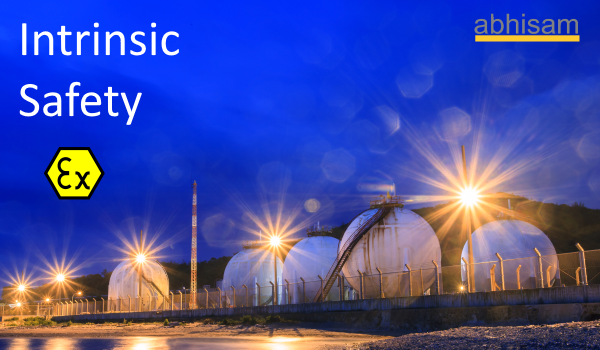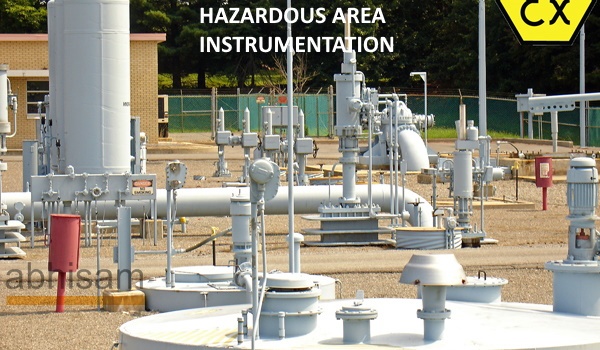Intrinsic Safety- How it works? What are Intrinsically Safe circuits
This Abhisam Whitepaper explains the rationale regarding Intrinsic Safety.
For more information about using Intrinsic Safety in hazardous areas, take the Abhisam Intrinsic Safety Training course.
Understanding Intrinsic Safety
Intrinsic Safety is a concept that came out of the mining industry in the early 19th century. At that time, a lot of mining accidents used to happen, many of which were traced to sparks that were generated by electrical circuits, that were used in mine lighting, signalling equipment and the like. These mining accidents were explosions resulting from the ignition of a mine gas called Firedamp (now known to be mainly composed of Methane). Due to the nature of the area (underground mines without ventilation), the gas used to be trapped inside and explode on contact with sparks. These mining explosions also had larger number of fatalities than say an above ground explosion would because of the confined area and the spreading of the fires and debris through underground passages.
To reduce the number of these accidents, it was proposed to use electrical equipment that could not generate sparks that could ignite the Firedamp.Thus was born Intrinsic Safety.
What is Intrinsic Safety?
Intrinsic Safety is a technique used to prevent explosions, which could be caused due to sparking of electrical apparatus in hazardous areas.
For the uninitiated, hazardous areas, are those areas of a plant or facility, that have a probable presence of explosive mixtures of gas, vapor or dust- present either for long periods of time above a certain duration-generally 10 hours or more in a year.
Intrinsic Safety is used to design and implement electrical circuits (mostly Instrumentation or measurement circuits), that will not have any sparking at all. There are other kinds of non sparking techniques of explosion protection, but these will not be covered here. (Scroll below to read more).

In Intrinsically safe circuits, a safety barrier is used between the “safe area” and the “hazardous area”, so that any fault that generates a high energy level (and sparks), would not get carried over to the hazardous area; it gets stopped at the safety barrier itself. Barriers are of infinite varieties, but broadly they can be classified as Zener barriers (passive devices) and Isolators (active devices). Functionally, they achieve the same objective, i.e. prevention of high energy levels from reaching the hazardous area.
The use of simple apparatus
There are certain simple devices that are classified as low power devices, these can be used without any safety barriers at all. They are called as “simple apparatus”. Examples are thermocouples and LEDs. This is a great concept and it makes designing measurement loops simpler.
Preventive techniques versus mitigative techniques
All of us know that “prevention” is better than cure. This principle is embodied in the principle of intrinsic safety, since the sparks are prevented from ever causing an explosion. In contrast to this, the explosionproof method of protection is mitigative as in case sparking happens in a hazardous area, the explosion does occur- only the effects are mitigated to some extent. Therefore, some engineers prefer Intrinsic Safety over Explosionproofing or similar methods.
Advantages and Disadvantages of Intrinsic Safety
The advantages of using intrinsic safety as a protection technique are many, but the most important one is that it is the only technique that is allowed to be used under Zone 0 of the IEC Classification system for hazardous areas. One cannot use any other technique like explosionproof (or increased safety or non incendive methods or any of the many other methods of protection) in Zone 0. Other advantages are that since it uses the entity concept, the designer can mix and match various compatible components to make the circuit intrinsically safe. It gives him/her greater flexibility. Also, using this technique eliminates the need for explosionproof junction boxes in the hazardous area, one can use weatherproof junction boxes too, with IS (intrinsically safe) loops.
The main disadvantage of this method is that, it can be used for only low power circuits; thus you cannot have heavy duty intrinsically safe motors for example. Typically the circuits are powered by 24 V dc power supplies. So Intrinsic Safety is mainly used for only measuring and control instruments like pressure transmitters, control valve positioners, small capacity solenoid valves and so on.
Some people feel that Intrinsic safety is complicated because it requires more engineering effort as one needs to select the instruments, select appropriate barriers and isolators, design proper grounding schemes and even select the right type of cable. However it is not complicated at all. You do need a step by step method, with examples, to understand how the process works and you’re done.
More information on Intrinsic Safety and Intrinsically Safe circuits
We have two excellent online courses where you can learn about Intrinsic Safety and get certified.
If you wish to know only about Intrinsic Safety Training then you can take the Abhisam Intrinsic Safety Course here. Covers everything in detail and comes with its own certificate.
If you wish to know about Intrinsic Safety as well as other methods of protection in Hazardous Areas, then you can take the Abhisam Hazardous Area Instrumentation course shown here.
The course explains much more than just intrinsic safety, of course. It covers the concepts of hazardous area instrumentation like no other! Plus you can take an Online Exam and get certified too, at no additional cost!

Intrinsic safety Symbol
The IEC symbol for Intrinsic Safety is Ex-i.
(Ex-i circuits are of either of three types Ex-ia OR Ex-ib OR Ex-ic).
We hope that you liked this short guide on Intrinsic Safety. To get more stuff like this, please subscribe to our mailing list.
Questions?
Do you have any questions regarding Intrinsic safety training? Please contact us by filling the form here.
Contact Us by filling the form below OR call us OR email
